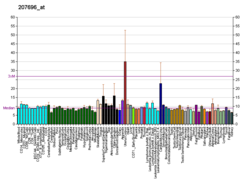Protein-coding gene in the species Homo sapiens
| FUT9 | |||||||||||||||||||||||||||||||||||||||||||||||||||
|---|---|---|---|---|---|---|---|---|---|---|---|---|---|---|---|---|---|---|---|---|---|---|---|---|---|---|---|---|---|---|---|---|---|---|---|---|---|---|---|---|---|---|---|---|---|---|---|---|---|---|---|
| Identifiers | |||||||||||||||||||||||||||||||||||||||||||||||||||
| Aliases | FUT9, Fuc-TIX, fucosyltransferase 9 | ||||||||||||||||||||||||||||||||||||||||||||||||||
| External IDs | OMIM: 606865; MGI: 1330859; HomoloGene: 4800; GeneCards: FUT9; OMA:FUT9 - orthologs | ||||||||||||||||||||||||||||||||||||||||||||||||||
| |||||||||||||||||||||||||||||||||||||||||||||||||||
| |||||||||||||||||||||||||||||||||||||||||||||||||||
| |||||||||||||||||||||||||||||||||||||||||||||||||||
| |||||||||||||||||||||||||||||||||||||||||||||||||||
| |||||||||||||||||||||||||||||||||||||||||||||||||||
| Wikidata | |||||||||||||||||||||||||||||||||||||||||||||||||||
| |||||||||||||||||||||||||||||||||||||||||||||||||||
Alpha-(1,3)-fucosyltransferase is an enzyme that in humans is encoded by the FUT9 gene.
FUT9 is one of several alpha-3-fucosyltransferases that can catalyze the last step in the biosynthesis of Lewis antigen, the addition of a fucose to precursor polysaccharides. FUT9 synthesizes the LeX oligosaccharide (CD15), which is expressed in organ buds progressing in mesenchyma during human embryogenesis.
References
- ^ GRCh38: Ensembl release 89: ENSG00000172461 – Ensembl, May 2017
- ^ GRCm38: Ensembl release 89: ENSMUSG00000055373 – Ensembl, May 2017
- "Human PubMed Reference:". National Center for Biotechnology Information, U.S. National Library of Medicine.
- "Mouse PubMed Reference:". National Center for Biotechnology Information, U.S. National Library of Medicine.
- Kaneko M, Kudo T, Iwasaki H, Ikehara Y, Nishihara S, Nakagawa S, Sasaki K, Shiina T, Inoko H, Saitou N, Narimatsu H (Jul 1999). "Alpha1,3-fucosyltransferase IX (Fuc-TIX) is very highly conserved between human and mouse; molecular cloning, characterization and tissue distribution of human Fuc-TIX". FEBS Lett. 452 (3): 237–42. doi:10.1016/S0014-5793(99)00640-7. PMID 10386598. S2CID 21861521.
- Kaneko M, Kudo T, Iwasaki H, Shiina T, Inoko H, Kozaki T, Saitou N, Narimatsu H (Jan 2000). "Assignment of the human alpha 1,3-fucosyltransferase IX gene (FUT9) to chromosome band 6q16 by in situ hybridization". Cytogenet Cell Genet. 86 (3–4): 329–30. doi:10.1159/000015329. PMID 10575236. S2CID 85080516.
- ^ "Entrez Gene: FUT9 fucosyltransferase 9 (alpha (1,3) fucosyltransferase)".
Further reading
- Bonaldo MF, Lennon G, Soares MB (1997). "Normalization and subtraction: two approaches to facilitate gene discovery". Genome Res. 6 (9): 791–806. doi:10.1101/gr.6.9.791. PMID 8889548.
- Nishihara S, Iwasaki H, Kaneko M, et al. (2000). "Alpha1,3-fucosyltransferase 9 (FUT9; Fuc-TIX) preferentially fucosylates the distal GlcNAc residue of polylactosamine chain while the other four alpha1,3FUT members preferentially fucosylate the inner GlcNAc residue". FEBS Lett. 462 (3): 289–94. doi:10.1016/S0014-5793(99)01549-5. PMID 10622713. S2CID 37842289.
- Cailleau-Thomas A, Coullin P, Candelier JJ, et al. (2000). "FUT4 and FUT9 genes are expressed early in human embryogenesis". Glycobiology. 10 (8): 789–802. doi:10.1093/glycob/10.8.789. PMID 10929005.
- Nakayama F, Nishihara S, Iwasaki H, et al. (2001). "CD15 expression in mature granulocytes is determined by alpha 1,3-fucosyltransferase IX, but in promyelocytes and monocytes by alpha 1,3-fucosyltransferase IV". J. Biol. Chem. 276 (19): 16100–6. doi:10.1074/jbc.M007272200. PMID 11278338.
- Roos C, Kolmer M, Mattila P, Renkonen R (2002). "Composition of Drosophila melanogaster proteome involved in fucosylated glycan metabolism". J. Biol. Chem. 277 (5): 3168–75. doi:10.1074/jbc.M107927200. PMID 11698403.
- Toivonen S, Nishihara S, Narimatsu H, et al. (2003). "Fuc-TIX: a versatile alpha1,3-fucosyltransferase with a distinct acceptor- and site-specificity profile". Glycobiology. 12 (6): 361–8. doi:10.1093/glycob/12.6.361. PMID 12107078.
- Li H, Kong Y, Yan B (2003). "". Sheng Wu Hua Xue Yu Sheng Wu Wu Li Xue Bao. 34 (6): 775–9. PMID 12417923.
- Strausberg RL, Feingold EA, Grouse LH, et al. (2003). "Generation and initial analysis of more than 15,000 full-length human and mouse cDNA sequences". Proc. Natl. Acad. Sci. U.S.A. 99 (26): 16899–903. Bibcode:2002PNAS...9916899M. doi:10.1073/pnas.242603899. PMC 139241. PMID 12477932.
- Nishihara S, Iwasaki H, Nakajima K, et al. (2004). "Alpha1,3-fucosyltransferase IX (Fut9) determines Lewis X expression in brain". Glycobiology. 13 (6): 445–55. doi:10.1093/glycob/cwg048. PMID 12626397.
- Mungall AJ, Palmer SA, Sims SK, et al. (2003). "The DNA sequence and analysis of human chromosome 6". Nature. 425 (6960): 805–11. Bibcode:2003Natur.425..805M. doi:10.1038/nature02055. PMID 14574404.
- Gerhard DS, Wagner L, Feingold EA, et al. (2004). "The status, quality, and expansion of the NIH full-length cDNA project: the Mammalian Gene Collection (MGC)". Genome Res. 14 (10B): 2121–7. doi:10.1101/gr.2596504. PMC 528928. PMID 15489334.
- Bogoevska V, Horst A, Klampe B, et al. (2006). "CEACAM1, an adhesion molecule of human granulocytes, is fucosylated by fucosyltransferase IX and interacts with DC-SIGN of dendritic cells via Lewis x residues". Glycobiology. 16 (3): 197–209. doi:10.1093/glycob/cwj057. PMID 16282604.
This article on a gene on human chromosome 6 is a stub. You can help Misplaced Pages by expanding it. |




